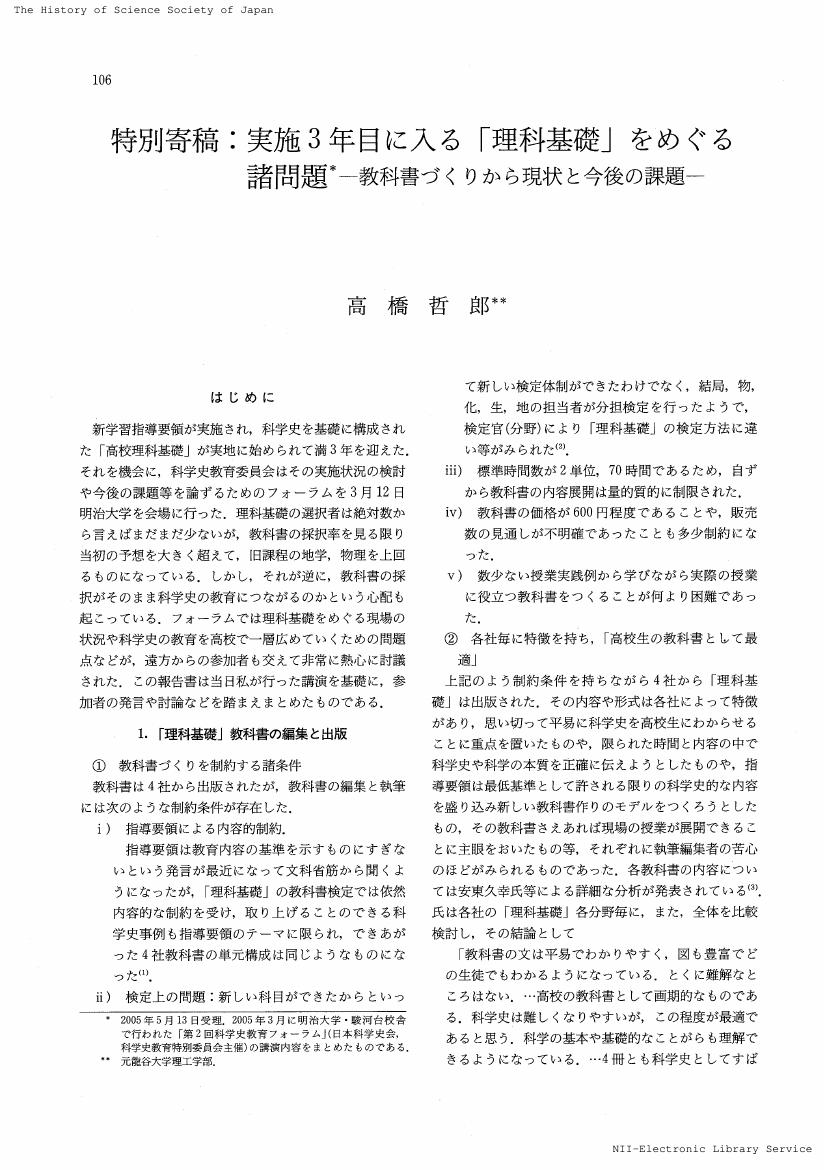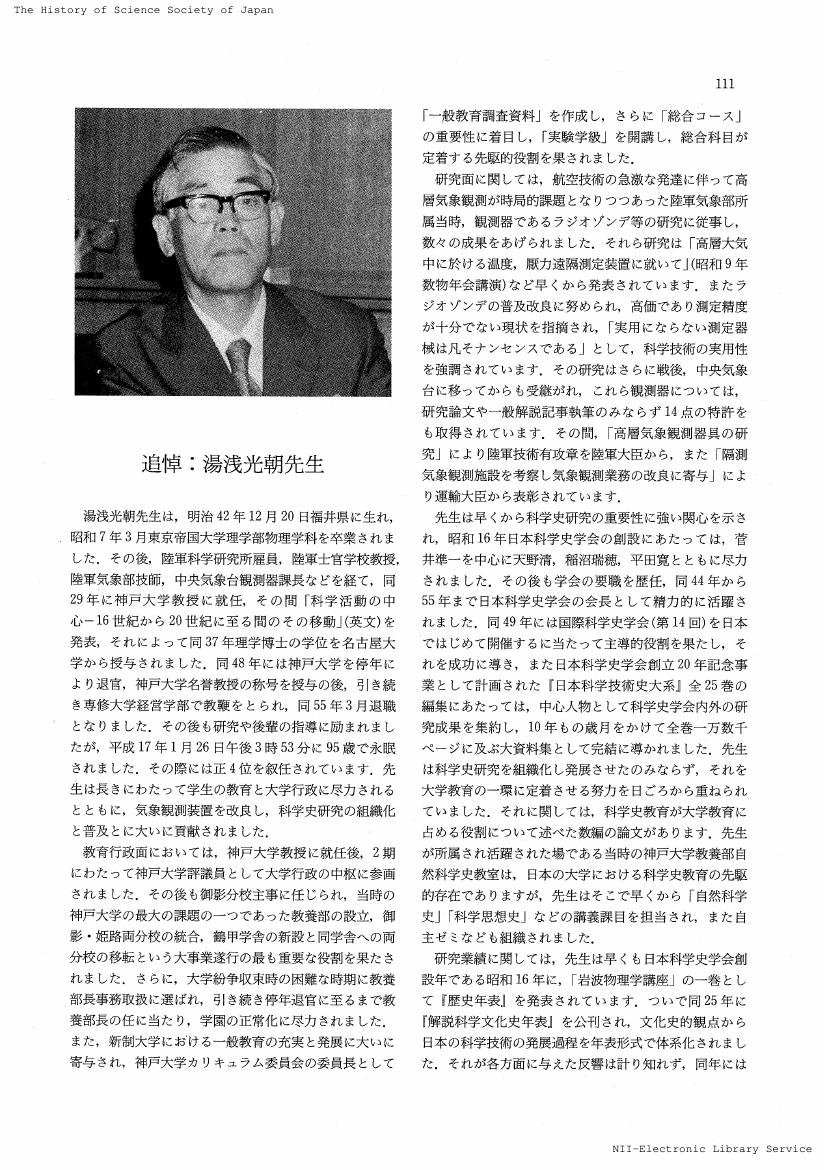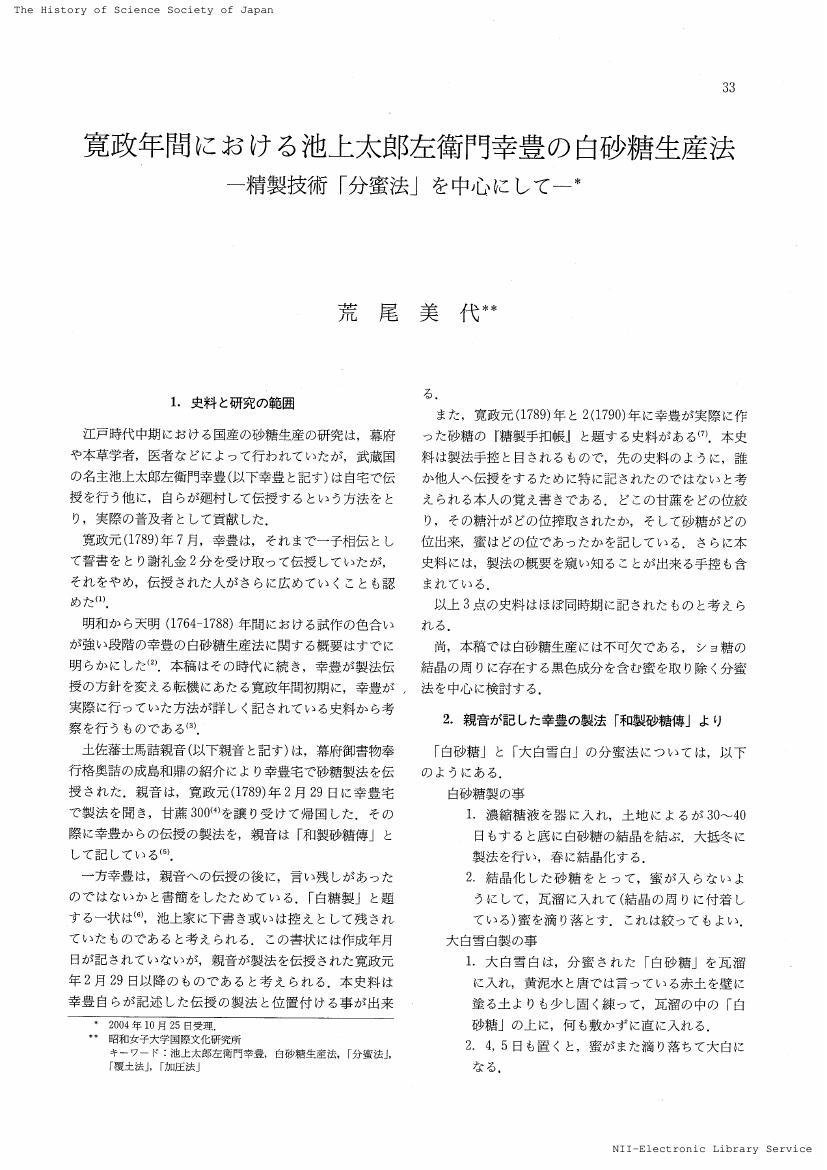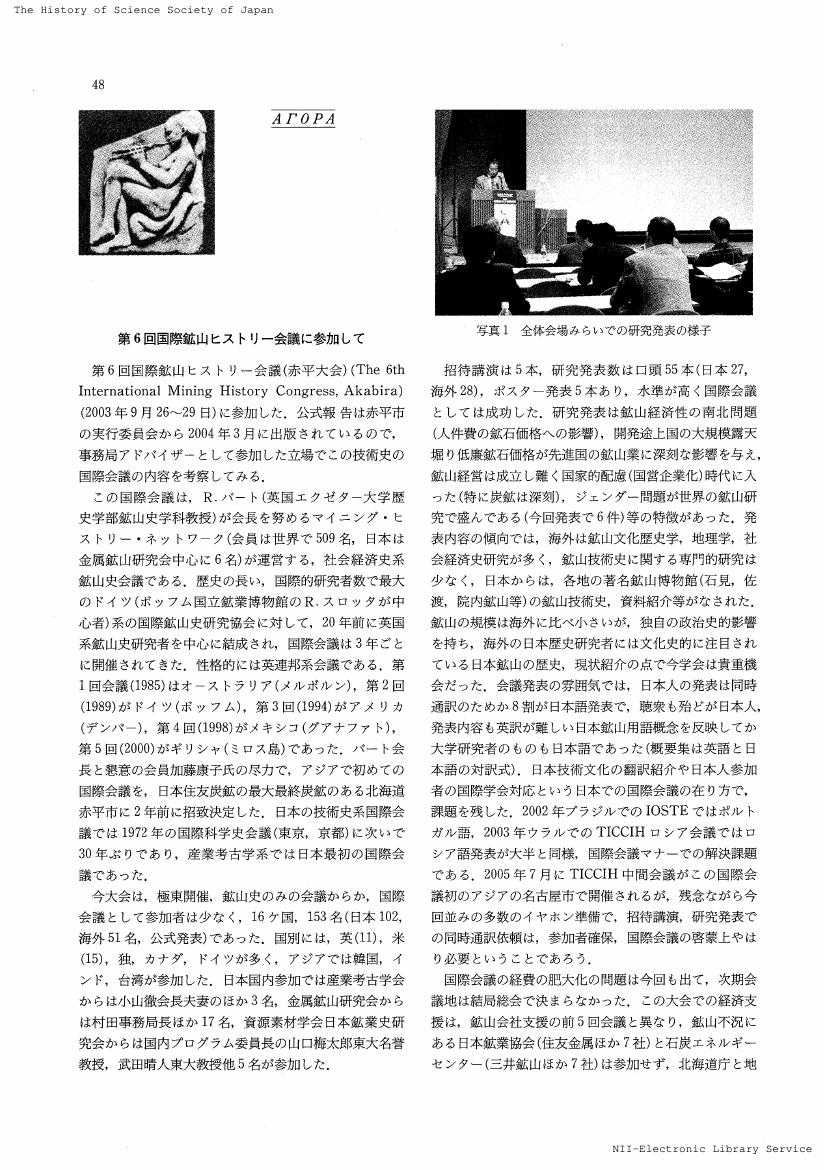1 0 0 0 OA 戦後日本の地質学に見られる歴史法則主義と現在主義
- 著者
- 泊 次郎
- 出版者
- 日本科学史学会
- 雑誌
- 科学史研究 (ISSN:21887535)
- 巻号頁・発行日
- vol.44, no.235, pp.129-138, 2005 (Released:2021-08-11)
After World War II, the Japanese geological community was involved in a passionate movement for democracy. In 1947 an association so called "Chidanken" was founded for the purpose of democratizing the geological community and collaborating on the geological research. Chidanken also generated a new research tradition that could be named "Historicism". The research tradition, which, became dominant in the Japanese geological community in 1950s, placed a special emphasis on discovering the law of the earth evolution. The historicism research tradition also produced geosynclinal mountain-building theory that had the idea that geosynclines possessed mountain-building forces within them. While there was another research tradition which remained since European geology had been introduced in the mid-nineteenth century. That could be named "Actuarism". There were many controversies over an origin of volcanic rocks and so on between the above two research traditions from 1950s to the beginning of 1970s. When plate tectonics was introduced into Japan in the end of 1960s, the adherence of the historicism research tradition did not accept plate tectonics, because plate tectonics was built on "Actuarism". Moreover geosynclinal mountain-building theory conflicted with plate tectonics that accounted for mountain-building as a consequence of plate motion. Consequently, it was not until the middle of 1980s that plate tectonics was generally accepted in the Japanese geological community.
1 0 0 0 OA 北海道農業技術史 : 開墾政策と農業移民の定着(第52回日本科学史学会年会報告)
- 著者
- 南部 悟
- 出版者
- 日本科学史学会
- 雑誌
- 科学史研究 (ISSN:21887535)
- 巻号頁・発行日
- vol.44, no.235, pp.139-142, 2005 (Released:2021-08-11)
1 0 0 0 OA 歴史学と工学のための技術移転論(科学史入門)
- 著者
- 鈴木 勉
- 出版者
- 日本科学史学会
- 雑誌
- 科学史研究 (ISSN:21887535)
- 巻号頁・発行日
- vol.44, no.235, pp.143-147, 2005 (Released:2021-08-11)
1 0 0 0 OA 鉄と硫黄の化合実験と共に五十年 : 実験の研究と学習の順序(科学史入門)
- 著者
- 三井 澄雄
- 出版者
- 日本科学史学会
- 雑誌
- 科学史研究 (ISSN:21887535)
- 巻号頁・発行日
- vol.44, no.235, pp.148-153, 2005 (Released:2021-08-11)
1 0 0 0 OA 第52回 日本科学史学会 年会・総会 報告
- 出版者
- 日本科学史学会
- 雑誌
- 科学史研究 (ISSN:21887535)
- 巻号頁・発行日
- vol.44, no.235, pp.154-158, 2005 (Released:2021-08-11)
1 0 0 0 OA 紹介
- 出版者
- 日本科学史学会
- 雑誌
- 科学史研究 (ISSN:21887535)
- 巻号頁・発行日
- vol.44, no.235, pp.159-173, 2005 (Released:2021-08-11)
1 0 0 0 OA 19世紀舶用ボイラ発達過程 : ボイラ史の研究方法によせて
- 著者
- 小林 学
- 出版者
- 日本科学史学会
- 雑誌
- 科学史研究 (ISSN:21887535)
- 巻号頁・発行日
- vol.44, no.236, pp.191-202, 2005 (Released:2021-08-11)
The historical development of steam boilers has been a popular issue among historians and engineers in Japan. The most prominent example is Seikan Ishigai. Drawing on his extensive study of the steam boiler, Ishigai defines the contradiction between power and control as an intrinsic law of the development of technology. In other words, he is a technological determinist. Trevor Pinch, Wiebe Bijker's approach (Social Construction of Technology : SCOT) and also Thomas Hughes's technological systems approach, on the other hand, give more weight to external factors, and do not give proper attention to technology's own dynamics. Critical of both the approaches, the author sees the relationship between engines and boilers as the locus of the development of the steam boiler. The author too argues that the quest for efficiency is a crucial factor in the development of marine steam engines. The author tries to show that the new engine entailed a different type of boiler, it was not opposite. That is the engine played a more crucial role than the boiler in the development of the marine propulsion system. It was the engine that moved a propeller or a paddle of a ship, not the boiler. He concludes that the history of the marine boiler is a history of relationship among the engine, the boiler and the propulsion system. An internalist or externalist approach alone may not be able to account for this complex relationship.
1 0 0 0 OA 1890年代後半におけるパッシェンの熱輻射研究の再考
- 著者
- 小長谷 大介
- 出版者
- 日本科学史学会
- 雑誌
- 科学史研究 (ISSN:21887535)
- 巻号頁・発行日
- vol.44, no.234, pp.75-85, 2005 (Released:2021-08-12)
Friedrich Paschen (1865-1947) was one of the notable experimental physicists in Germany investigating the spectrum of hydrogen atom, especially spectral series, at the beginning of 20th century. As a part of research related to the spectroscopy, he was engaged with the heat radiation problems in the latter half of the 1890's. However his achievement of this area was not regarded as an important experimental work compared to his spectroscopic researches. This paper reconsiders Paschen's experimental research of radiation in late 1890's. In order to approach that topic, we mainly analyze the setup of radiation sources, the assembly of his bolometer and the range of wavelength of radiation and temperature of radiating bodies in his research. In this paper the features of his experiments are reevaluated in the context of development of radiation experiments during that time. It was certain that Paschen used the source of cavity radiation later than Lummer and Pringsheim and made confirmations of the radiation law in the narrower range of wavelength of radiation than other experimentalists in 1899-1900. However he did work out "numerous experimental confirmations " concerning the radiation law and did give any possible support for the establishment of Planck's radiation law until late 1900.
1 0 0 0 OA 少数民族の抄紙法の解析に基づく「撈紙法」発達過程の考察
- 著者
- 小林 良生
- 出版者
- 日本科学史学会
- 雑誌
- 科学史研究 (ISSN:21887535)
- 巻号頁・発行日
- vol.44, no.234, pp.86-96, 2005 (Released:2021-08-12)
Based on the same presumption on the molding methods reported previously, the development steps of squeezing techniques in hand papermaking were surveyed and estimated from the analyses of hand papermaking conserved by minorities in and around southern China. The initial step of the shift from molding process was to make paper from squeezing in a deep vat dispersed plant fiber by using a screen fixed with frame. As the second improvement, a screen separable from frame was invented for production efficiency. The second step was to squeeze a suspension of plant fibers dispersed without mucilages by using the separable screen and frame and then to dry each a piece of wet sheet on a board or wall without pressing. The third step was to add the process of pressing a pile of wet sheets for improvement of paper bulk density and strength. In this pressing process, felts were first inserted between each wet sheet for preventing from mutually sticking these sheets. Finally the squeezing method was refined to reach the 'nagashizuki' technique by which a pile of wet webs are permitted to be pressed without inserted felts for peeling each sheet off.
1 0 0 0 OA 実施3年目に入る「理科基礎」をめぐる諸問題 : 教科書づくりから現状と今後の課題
- 著者
- 高橋 哲郎
- 出版者
- 日本科学史学会
- 雑誌
- 科学史研究 (ISSN:21887535)
- 巻号頁・発行日
- vol.44, no.234, pp.106-110, 2005 (Released:2021-08-12)
1 0 0 0 OA 湯浅光朝先生
- 著者
- 三浦 伸夫
- 出版者
- 日本科学史学会
- 雑誌
- 科学史研究 (ISSN:21887535)
- 巻号頁・発行日
- vol.44, no.234, pp.111-113, 2005 (Released:2021-08-12)
1 0 0 0 OA 紹介
- 出版者
- 日本科学史学会
- 雑誌
- 科学史研究 (ISSN:21887535)
- 巻号頁・発行日
- vol.44, no.234, pp.114, 2005 (Released:2021-08-12)
1 0 0 0 OA 復古王政期フランスの技術書出版ブーム
- 著者
- 中村 征樹
- 出版者
- 日本科学史学会
- 雑誌
- 科学史研究 (ISSN:21887535)
- 巻号頁・発行日
- vol.44, no.233, pp.1-12, 2005 (Released:2021-08-12)
In Restoration France 1814-1830, the advancement of industrialization had encouraged the mechanization of manufacturing processes, while weakening the apprenticeship as a legitimate training system for the artisans. In such circumstances, technical books began to emerge as a new channel to technical information. These technical books flourished especially in the latter half of the 1820s. This paper focuses on this "boom" of technical books in Restoration France. By conducting a quantitative analysis of Bibliographie de la France, the publication trend of the technical books will be examined, particularly with respect to format and price. From this analysis, it has be shown that the boojcs which triggered such a boom were the "manuals" -small in format, and moderately priced- of particular professions. These were elementary technical books available to the ordinary artisans. In order for these "manuals" to be actually useful, the contents mainly consisted of "practical knowledge," for each targeted profession. Moreover, in most of these manuals, the use of scientific terms were avoided, and instead, descriptions were given in everyday language. Indeed, some of them went as far as using the traditional measurement system, rather than the metric system. Although the actual number of copies of these "manuals" cannot be determined from existing data, presumably they had achieved certain commercial success. In fact, such manuals continued to be published constantly even after the 1830s, and a few of them became so popular that the revised editions had been published one after another.
1 0 0 0 OA 「自然」(フュシス)と身体 : ポリュボス『人間本性論』における医学的「自然」観
- 著者
- 今井 正浩
- 出版者
- 日本科学史学会
- 雑誌
- 科学史研究 (ISSN:21887535)
- 巻号頁・発行日
- vol.44, no.233, pp.13-22, 2005 (Released:2021-08-12)
It has often been claimed that Greek medical science has its origin in the rational explanation of the world among the early Greek philosophers that constituted their inquiry into nature. However, there were doctors who made an attempt to establish medical science as existing independently of any philosophical intrusion. This can be elucidated through the analysis of the medical term physis, conceptualized, among others, in the well- known treatise in the Hippocratic Corpus, entitled De Natura Hominis (NH). In NH, the Hippocratic doctor criticizes philosophical anthropology and medical theory, which hold that human nature comes into being emergently from single elemental stuff such as Air, Water etc, or from a single humor. His own view of human nature claims that the four humors (blood, phlegm, yellow bile and black bile) constitute the nature (physis) of human body. The human body has its natural powers inherently for preserving health, and, if anything does harm to it, it functions autonomously for restoring its normal condition. In this context, the term physis denotes what determines the normality of the body, in which its humoral constituents remain harmonized with each other. Through the conception of physis, applied principally to the body, the human body will be demarcated as the physical or ,material aspect of human nature, as opposed to the monistic view of human nature, which has not drawn a categorical distinction between the material and non-material.
1 0 0 0 OA 寛政年間における池上太郎左衛門幸豊の白砂糖生産法 : 精製技術「分蜜法」を中心にして
- 著者
- 荒尾 美代
- 出版者
- 日本科学史学会
- 雑誌
- 科学史研究 (ISSN:21887535)
- 巻号頁・発行日
- vol.44, no.233, pp.33-38, 2005 (Released:2021-08-12)
1 0 0 0 OA シーボルトと日本の植物(科学史入門)
- 著者
- 石山 禎一
- 出版者
- 日本科学史学会
- 雑誌
- 科学史研究 (ISSN:21887535)
- 巻号頁・発行日
- vol.44, no.233, pp.39-42, 2005 (Released:2021-08-12)
1 0 0 0 OA 国際地質学史委員会2004に参加して(アゴラ)
- 著者
- 矢島 道子 山田 俊弘
- 出版者
- 日本科学史学会
- 雑誌
- 科学史研究 (ISSN:21887535)
- 巻号頁・発行日
- vol.44, no.233, pp.46-47, 2005 (Released:2021-08-12)
1 0 0 0 OA 第6回国際鉱山ヒストリー会議に参加して(アゴラ)
- 著者
- 山田 大隆
- 出版者
- 日本科学史学会
- 雑誌
- 科学史研究 (ISSN:21887535)
- 巻号頁・発行日
- vol.44, no.233, pp.48-49, 2005 (Released:2021-08-12)
1 0 0 0 OA 紹介
- 出版者
- 日本科学史学会
- 雑誌
- 科学史研究 (ISSN:21887535)
- 巻号頁・発行日
- vol.44, no.233, pp.50, 2005 (Released:2021-08-12)
1 0 0 0 OA 中国周辺の少数民族の抄紙法から見た「澆紙法」の発達過程の考察
- 著者
- 小林 良生
- 出版者
- 日本科学史学会
- 雑誌
- 科学史研究 (ISSN:21887535)
- 巻号頁・発行日
- vol.43, no.232, pp.193-203, 2004 (Released:2021-08-12)
On the presumption that minorities in Southern China and her peripheral countries still conserve ancient papermaking techniques, field and literature surveys were made for extraction of elemental techniques of hand papermaking and arranging them in the developing order from viewpoints of paper science. These techniques are classified into two methods, molding and squeezing of pulp (or plant fibers) suspension. In this report developing steps of molding method were observed and discussed. The author propose that the most primitive technique is to disperse a viscous solution dispersed with plant fibers on horizontally supported dry canvas as observed in Yao tribes. The next step is floating mold in which water pools are provided in several ways. Finally floating mold using a shallow vat with legs made it possible to make paper by a standing figure. Further the sallow vat is improved to provide bamboo bars at the edge for putting frames containing wet sheets.












